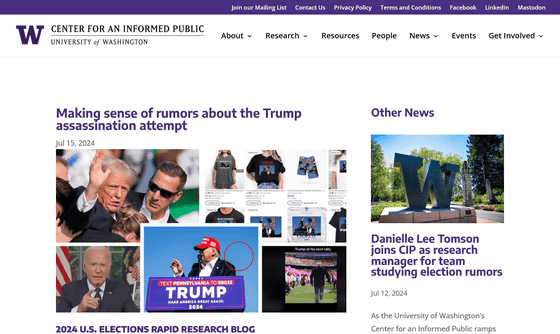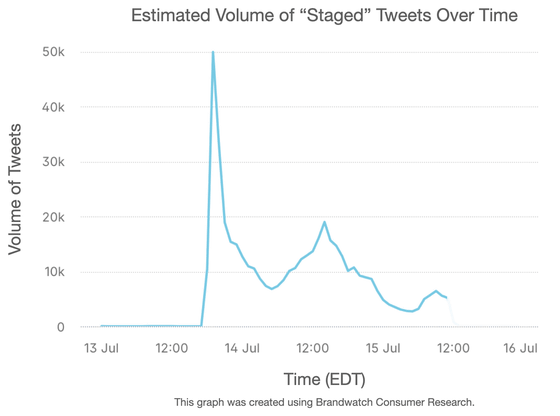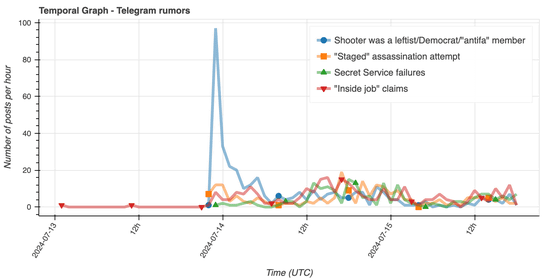'How do people react online to shocking events?' analyzed through the attack on former President Trump

By
When a notable incident or accident occurs in the world, many people check the facts on the Internet or check the rumors of information hidden behind the facts. The results of an investigation into the transmission of such information and rumors on the Internet are shown using the example of the attack on former President Donald Trump that occurred on July 14, 2024.
Making sense of rumors about the Trump assassination attempt | Center for an Informed Public
https://www.cip.uw.edu/2024/07/15/trump-assassination-rumors-collective-sensemaking/

After Trump shooting, UW researchers try to make quick sense of online reaction, rumors and more – GeekWire
https://www.geekwire.com/2024/after-trump-shooting-uw-researchers-try-to-make-quick-sense-of-online-reaction-rumors-and-more/
On July 14, 2024, former President Donald Trump was shot while speaking at a campaign rally in Pennsylvania. Trump was bleeding but was not in any danger of dying, one audience member was killed and two were seriously injured at the scene, and one suspect believed to have been the shooter was killed.
Former President Donald Trump was shot at a rally, injuring his right ear, killing one suspect and one audience member - GIGAZINE

Following this incident, the University of Washington's Center for Information and Public Affairs (CIP) analyzed something called 'collective sensemaking,' in which people use social media to gather evidence and choose the frameworks that shape how they interpret that evidence. Collective sensemaking has two main components: 'collection of potential evidence' and 'framing.' Roughly speaking, the former is fact-finding and the latter is interpretation from the facts.
In the face of such shocking events, researchers point out that trends such as unpredictable and uncertain information space, political framing disputes, and conspiracy theories are likely to occur. This is where collective meaning-making comes into play. In his 1966 book Improvised News , sociologist Tamotsu Shibutani wrote, 'Rumors help us assign meaning to uncertain and rapidly unfolding events. From this perspective, rumors can be true or false, because they are defined not by their factuality but by their unverified nature and spread through informal channels.' In modern society, when the facts about shocking events are unclear in a digital space where immediacy is increasingly valued, rumors have taken root on the Internet and become indispensable.

According to CIP's research, within five minutes of the attack on former President Trump, information was circulating about 'who did this and why.' The formation of rumors was spread in a chain reaction by social media, with the perpetrator being named on Telegram as a member of the anti-fascist movement
CIP divides three broad political frames that circulated as rumors in the days following the attack. The first, which spread immediately after the attack, was that the attack was staged for former President Trump's political gain, in which he injured himself and was filmed by a strategically placed photographer. This initial frame exploded in popularity immediately after the attack, but quickly faded as more details of the incident became clear. The graph below shows a time series of posts on X discussing the attack using the word 'staged,' which peaked in the first two hours after the attack and then quickly died down. This was because credible news outlets reported it as a legitimate assassination attempt and the shooter was identified.

After the sensational rumor that 'former President Trump staged the incident' died down, the focus shifted to the second frame of 'Secret Service failure.' As many reports and individual posts spread and details of the actual scene became clear, it became a hot topic to point out that 'the Secret Service's response to former President Trump was much slower than the 1981 assassination attempt on President Ronald Reagan .' As with the former President Trump staged the incident, influencers' posts with political motives were confirmed, and CIP pointed out that 'this frame is expected to continue to spread online.' The third point, which became more conspiratorial, suggested some kind of 'internal crime.'
The image below shows the four major rumors about the attack on former President Trump, with the number of posts over time. Blue indicates that the left is involved, orange indicates that it was staged, green indicates that it was an inside job, and red indicates that it was an inside job.

Another notable aspect of the spread of rumors surrounding the attack is the criticism of mainstream media, which CIP cites. While collective meaning-making on social media is rapid and widespread, journalists can take time to obtain reliable clues and then publish them with accurate interpretations. Criticism can also be directed at news media that report inaccurate or ambiguous information. As Elon Musk posted on X, 'Traditional media is a pure propaganda machine. X is the voice of the people,' many users supported social media as a faster, more reliable, and less biased source of breaking news than news media.
The legacy media is a pure propaganda machine. 𝕏 is the voice of the people.
https://t.co/oTKsmrIMms — Elon Musk (@elonmusk) July 14, 2024
Additionally, the subcultural movement surrounding the incident has also been noteworthy, including the recent increase in image and movie creation speed using generative AI. The more shocking the incident, the more pop culture-inspired posts and memes are generated on social media to explain or make light of it, such as posts parodying the bullet-dodging scene in the movie 'The Matrix.' CIP also noted the swift movement to commercialize photos of high-impact incidents, which could be used to share ideas and boost support for former President Trump in the aftermath of the crisis.

CIP researcher Kate Starbird, when reporting the findings of this investigation, pointed out that the online reactions were not conspiratorial manipulation by external nation states or non-state actors, but spontaneous posts by individuals. 'What we have seen is a political framing contest. Almost from the beginning, people try to frame information about the event in a way that is favorable to their political goals. Online influencers do this for two reasons: one is to advance their own political goals, but the other is to gain attention, build reputations, and gain followers,' she said.
CIP explains, 'Rumors are a natural part of human life, a natural social process in which we all participate, especially in moments of crisis when emotions are high and facts are uncertain and changing. In these circumstances, everyone makes mistakes and is susceptible to becoming embroiled in conspiracy theories. Bad actors, pranksters and political operatives are more likely to distort facts and interpretations, and scammers and entrepreneurs exploit sensationalism to spread falsehoods or sell products. Our hope with this research report is not to problematize rumor sharing, but to help people understand the human vulnerability to deliberate manipulation during times of crisis and social unrest.'
Related Posts:
in Note, Posted by log1e_dh







